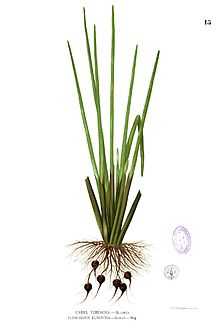Eleocharis dulcis
| Chinese water chestnut | |
|---|---|
 | |
| illustration circa 1880[1] | |
| Scientific classification | |
| Kingdom: | Plantae |
| (unranked): | Angiosperms |
| (unranked): | Monocots |
| (unranked): | Commelinids |
| Order: | Poales |
| Family: | Cyperaceae |
| Genus: | Eleocharis |
| Species: | E. dulcis |
| Binomial name | |
| Eleocharis dulcis (Burm.f.) Trin. ex Hensch. | |
| Synonyms | |
| |

| Nutritional value per 100 g (3.5 oz) | |
|---|---|
| Energy | 406 kJ (97 kcal) |
|
23.94 g | |
| Sugars | 4.8 g |
| Dietary fiber | 3 g |
|
0.1 g | |
|
1.4 g | |
| Vitamins | |
| Thiamine (B1) |
(12%) 0.14 mg |
| Riboflavin (B2) |
(17%) 0.2 mg |
| Niacin (B3) |
(7%) 1 mg |
|
(10%) 0.479 mg | |
| Vitamin B6 |
(25%) 0.328 mg |
| Folate (B9) |
(4%) 16 μg |
| Vitamin C |
(5%) 4 mg |
| Vitamin E |
(8%) 1.2 mg |
| Trace metals | |
| Magnesium |
(6%) 22 mg |
| Manganese |
(16%) 0.331 mg |
| Phosphorus |
(9%) 63 mg |
| Potassium |
(12%) 584 mg |
| Zinc |
(5%) 0.5 mg |
|
| |
| |
|
Percentages are roughly approximated using US recommendations for adults. Source: USDA Nutrient Database | |
The Chinese water chestnut (Eleocharis dulcis), more often called simply the water chestnut, is a grass-like sedge native to Asia (China, Japan, India, Philippines, etc.), Australia, tropical Africa, and various islands of the Pacific and Indian Oceans.[2] It is widely grown in many countries for its edible corms.[3]
The water chestnut is actually not a nut at all, but an aquatic vegetable that grows in marshes, underwater in the mud. It has tube-shaped, leafless green stems that grow to about 1.5 metres. The water caltrop, which is also referred to by the same name, is unrelated and often confused with the water chestnut.
The small, rounded corms have a crisp white flesh and can be eaten raw, slightly boiled, or grilled, and are often pickled or tinned. They are a popular ingredient in Chinese dishes. In China, they are most often eaten raw, sometimes sweetened. They can also be ground into a flour form used for making water chestnut cake, which is common as part of dim sum cuisine. They are unusual among vegetables for remaining crisp even after being cooked or canned, because their cell walls are cross-linked and strengthened by certain phenolic compounds, like oligomers of ferulic acid.[4] This property is shared by other vegetables that remain crisp in this manner, including the tiger nut and lotus root.[5]
The corms are rich in carbohydrates (about 90 percent by dry weight), especially starch (about 60 percent by dry weight), and are also a good source of dietary fiber, riboflavin, vitamin B6, potassium, copper, and manganese.[6]
If eaten uncooked, the surface of the plants can transmit Fasciolopsiasis.[7]
Taste
Raw water chestnuts are slightly sweet and very crunchy. Boiled water chestnuts have a firm and slightly crunchy texture, with a flavor that is very mild and slightly nutty, so it can be easily overpowered by any seasonings or sauces with which the water chestnut is served or cooked. Water chestnuts are often combined with bamboo shoots, coriander, ginger, sesame oil, and snow peas. They are often used in noodle or rice dishes.[8]
Nomenclature
The Chinese water chestnut (traditional Chinese: 荸薺; simplified Chinese: 荸荠; hanyu pinyin: bíqi, 馬蹄; pinyin:mǎtí) is native to China and is widely cultivated in flooded paddy fields in southern China and parts of the Philippines. In Vietnam, it is called củ mã thầy (in the North) and củ năng (in the South) and is the main ingredient of bánh củ năng hấp, chè mã thầy. In Thailand it is called somwang (สมหวัง) and it is often used in dessert as tabtim krob (ทับทิมกรอบ). In India it is commonly known as Singhada, shingada or singoda.
References
- ↑ Flora de Filipinas [...] Gran edicion [...] [Atlas I]. Date=1880-1883? Author=Francisco Manuel Blanco (O.S.A.)
- ↑ Kew World Checklist of Selected Plant Families
- ↑ Flora of China, Vol. 23 Page 191, 荸荠 bi qi, Eleocharis dulcis (N. L. Burman) Trinius ex Henschel, Vita Rumphii. 186. 1833.
- ↑ Phenolics and phenolic-polysaccharide linkages in Chinese water chestnut (Eleocharis dulcis) cell walls. Grassby Terri, Doctoral thesis, 2008, University of East Anglia (link)
- ↑ McGee, Harold (2004). On Food and Cooking (Revised Edition). Scribner. p. 308. ISBN 0-684-80001-2.
- ↑ "Waterchestnuts, chinese, (matai), raw". NutritionData.com. CondéNet, Inc. Retrieved 2007-12-31.
- ↑ Fasciolopslasis--a re-emerging infection in Azamgarh (Uttar Pradesh). Bhatti HS, Malla N, Mahajan RC, Sehgal R. Indian J Pathol Microbiol. 2000 Jan;43(1):73-6. PMID 12583425
- ↑ Green, Aliza (2004). Field Guide to Produce. Quirk Productions. p. 284. ISBN 1-931686-80-7.
External links
| Wikimedia Commons has media related to Eleocharis dulcis. |